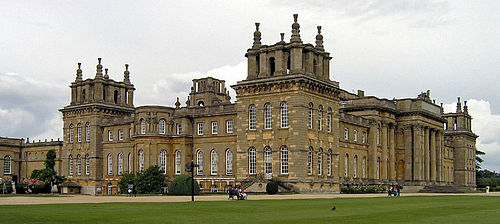From Wikipedia, the free encyclopedia
| Blenheim Palace | |
|---|---|
|
Location within Oxfordshire
| |
| General information | |
| Location | Oxfordshire, England |
| Coordinates | 51°50′31″N 01°21′41″WCoordinates: 51°50′31″N 01°21′41″W |
| Official name | Blenheim Palace |
| Type | Cultural |
| Criteria | ii, iv |
| Designated | 1987 (11th session) |
| Reference no. | 425 |
| Region | Europe and North America |
Blenheim Palace (pronounced /ˈblɛnɪm/ blen-im[1]) is a monumental country house situated in Woodstock, Oxfordshire, England. It is the principal residence of the Dukes of Marlborough, and the only non-royal non-episcopal country house in England to hold the title of palace. The palace, one of England's largest houses, was built between 1705 and circa 1722. Blenheim Palace was designated a UNESCO World Heritage Site in 1987.[2]
The building of the palace was originally intended to be a reward to John Churchill, 1st Duke of Marlborough, from a grateful nation for the duke's military triumphs against the French and Bavarians during the War of the Spanish Succession, culminating in the 1704 Battle of Blenheim. However, soon after its construction began, the palace became the subject of political infighting; this led to Marlborough's exile, the fall from power of his duchess, and lasting damage to the reputation of the architect Sir John Vanbrugh.
Designed in the rare, and short-lived, English Baroque style, architectural appreciation of the palace is as divided today as it was in the 1720s.[3] It is unique in its combined use as a family home, mausoleum and national monument. The palace is also notable as the birthplace and ancestral home of Sir Winston Churchill.
Following the palace's completion, it became the home of the Churchill, later Spencer-Churchill, family for the next 300 years, and various members of the family have wrought changes to the interiors, park and gardens. At the end of the 19th century, the palace was saved from ruin by funds gained from the 9th Duke of Marlborough's marriage to American railroad heiress Consuelo Vanderbilt. The exterior of the palace remains in good repair.
基德靈頓?沒聽說過? 99%的英國人可能也沒聽說過。為什麼一個幽靜的英格蘭村莊引來大批中國遊客?
這個問題,牛津郡這個姥姥不疼舅舅不愛的小村的村民們也一直在捫心自問,不得其解,很苦惱。
自從今年夏天旅遊大巴把一車車的中國遊客卸到這兒以來,這個距牛津以北大約五英里(約八公里)的基德靈頓Kidlington村的村民們寧靜的生活就被攪翻了。
中國人來了
基德靈頓沒有什麼特別的地方,但中國遊客似乎對村裏的一磚一瓦,一草一木都興致盎然,一個勁兒的拍照,連門外的垃圾桶都不放過。
中國人的突然湧入不但成了村民們的談資,也成了英國的全國新聞,甚至成了世界新聞。
記者們也跟著進了村,但似乎也理不出個頭緒。英國媒體的"推論"之一是,中國遊客被一家惡作劇的旅行社耍弄,說這個村莊是小說哈利·波特中主人翁的童年故居所在地。《太陽報》開玩笑說,或許是超自然的力量把中國人送到了基德靈頓。
導遊"使壞"
解鈴還須繋鈴人。中國遊客為何來到基德靈頓? 把他們送到那兒的中國導遊揭了謎底。
基德靈頓的村民也別自作多情,原來中國人來基德靈頓,跟基德靈頓本身無關。
 RUSSELL GRIFFIN
RUSSELL GRIFFIN
說來很簡單。北京市華遠國際旅遊有限公司的導遊孫建鋒解釋說,不願額外花68美元,去附近的布萊尼姆宮(Blenheim Palace)參觀的中國遊客,被導遊"暫存"在了基德靈頓村。
布萊尼姆宮是溫斯頓·丘吉爾(Winston Churchill)的祖居,去那裏參觀不是旅行團的必選項。
為什麼放在基德靈頓村?因為原先的集合地點是在布萊尼姆宮附近。一些遊客發現,不從旅遊團訂票,而是在布萊尼姆宮現場買票,只花大約25美元,因此悄悄自己步行前往那裏。
導遊丟了生意,其他已經付了高價的遊客也很生氣。
因此,孫建鋒說,那些選擇不參觀布萊尼姆宮的人就被留在8公里外的基德靈頓,從那裏無法步行前往布萊尼姆宮。



沒有留言:
張貼留言
注意:只有此網誌的成員可以留言。